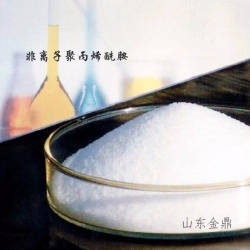White solid particles
Our company specializes in the production of polyacrylamide (PAM). The polyacrylamide produced by the company using low temperature initiation technology can reach 20 million molecular weight and the production cost can be reduced by 15%. Our company has rich experience in papermaking, medicine, brewing, coal washing, electric power, mineral processing, and urban sewage treatment.
Polyacrylamide for coal washing: two major advantages: 1. Using our company's special polyacrylamide for coal washing, after analysis by azet potentiometer, the price difference with other products is at least 500 yuan/T, up to 2000 yuan. /T. The above situation must be achieved after the customer provides the coal washing water and the current products. 2. For the washing water of complex water quality, the company's products can be used without adding polyaluminum chloride, and only the polyacrylamide for coal washing can be used.
Chemical properties:
※ Appearance: white particles
※solid content: ≥88%
※Molecular weight: 2-12 million
※Load density: <5.0 (Mole%)
PH (0.1% SOL): 7.0 to 8.0
Ionic: nonionic
Aqueous solution viscosity (0.1% SOL): 300 to 550 (CPS)
Moisture: 10% or less
Residual monomer (monomer) 0.2% or less
Physical properties:
The physical properties of nonionic polyacrylamide are mainly determined by the behavior in aqueous solution. Since the molecular chain contains an amide group or an ionic gene, it is characterized by high hydrophilicity, can be dissolved in water in various proportions, and the polyacrylamide aqueous solution is The electrolyte is very tolerant, such as amine chloride, sodium sulfate, etc. are not sensitive, and the surfactant is also compatible.
Other properties of nonionic polyacrylamide:
1. It has good water solubility and can be completely dissolved in cold water.
2, adding a small amount of non-ionic polyacrylamide, you can get a great flocculation effect. Generally, only 0.01~10ppm (0.01~10g/m3) can be added to fully function.
3. Simultaneous use of nonionic polyacrylamide and inorganic flocculant (polyferric sulfate, polyaluminum chloride, iron salt, etc.) can show greater effects.
Application areas:
1. As a flocculant, it is mainly used in industrial solid-liquid separation process, including sedimentation, clarification, concentration and sludge dewatering. The main industries used are: urban sewage treatment, paper industry, food processing industry, petrochemical industry, Wastewater treatment in the metallurgical industry, the beneficiation industry, the dyeing industry and the sugar industry and various industries. Used in the municipal sewage and sludge, sludge and sludge dewatering in the treatment of meat, poultry and food processing wastewater, through the positive charge groups contained in it, the neutral neutralization of the negatively charged organic colloid in the sludge and The excellent bridging function of the polymer causes the colloidal particles to aggregate into a large floc and separate from the suspension. The effect is obvious and the dosage is small.
2. It can be used as paper dry strength agent, retention aid and filter aid in the paper industry, which can greatly improve the quality of paper formation, save costs and improve the production capacity of paper mills. It can directly bridge the inorganic salt ions, fibers and other organic polymers to enhance the physical strength of the paper, reduce the loss of fibers or fillers, speed up the filtration, enhance, retain and filter, and can also be used The treatment of white water, at the same time, can have a significant flocculation effect during the deinking process.
3. In the fiber slurry (asbestos-cement product), the asbestos-cement product can be improved in drainage and the strength of the asbestos board material can be improved; in the insulating plate, the bonding ability of the additive and the fiber can be improved.
4. It can be used as clarifying agent for mine wastewater and coal washing wastewater in mining and coal preparation industry.
5, can be used for the treatment of dyeing wastewater, leather wastewater, oily wastewater, to remove turbidity, decolorization, in order to meet emission standards.
6. In the purification of phosphoric acid, it contributes to the separation of gypsum in the wet process phosphoric acid process.
7. Water treatment flocculant used in waterworks of rivers and rivers.
Instructions:
1. When used, it is formulated into an aqueous solution of 0.1% concentration, and it is preferred to use water containing neutral salt-free impurities.
2. When dissolving, sprinkle non-ionic polyacrylamide evenly into the stirred water and control the stirring speed at 100~300rpm.
3. Appropriate heating (<60 °C) can accelerate dissolution. Adjust the pH of the treated liquid to make the non-ionic polyacrylamide fully function (select the optimum pH and the amount of non-ionic polyacrylamide by experiment).
4. When adding the non-ionic polyacrylamide solution, it should accelerate the mixing with the treated liquid. After the flocculation occurs, slow the stirring speed to facilitate the floc growth and accelerate the sedimentation.
Precautions:
1. The operator should wear protective equipment. After skin contact, wash it off with water.
2, the use of the site, often rinsed with water to prevent slipping injuries.
3, non-ionic polyacrylamide should be sealed and stored in a cool dry place.
The main purpose:
1. It has special effects on organic colloidal suspensions, which can quickly promote sludge dewatering and filtration. According to the nature of the sludge, the corresponding model can be selected. When the dewatering is not sticky, the filter cloth is not loose, and the pressure is not loose, and the efficiency is high.
2. It is used for the treatment of organic sewage, such as electroplating, printing and dyeing, waste water from oil and fat plants, alcohol, monosodium glutamate, sugar production, wastewater from meat products factories, and urban sewage.
3, used for paper reinforcement, improve the wet and dry strength of the paper, such as adding this product in the papermaking process, can increase the wet paper tension of the paper by 10-20 times, dry paper tension by 50%, mainly used for kraft paper, map paper , advertising paper, photo paper. Used in oilfield chemical additives.
4, used for textile sizing agent, slurry performance is stable, less pulping, fabric breakage rate is low, cloth surface is smooth.


